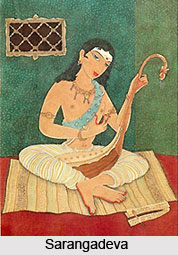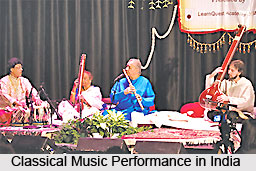Carnatic music, associated with the southern part of India is one of the important sub genres of the Indian classical music. Confined to mainly four modern Indian states like, Andhra Pradesh, Kerala, Tamil Nadu and Karnataka, Carnatic music with its taala, laya and raga, is more than just an amalgamation of musical notes, rhythm and melody but is an eternal journey amidst the vibrancy of euphony ; a sheer musical sojourn representing the Indian heritage.
Like all art forms in Indian culture, Carnatic music is believed to have a divine origin, thus it has its origins deeply rooted in the antiquities of the Vedas. Even in the Upanishads there are references to music and musical instruments. Epics like Ramayana and Mahabharata also have some references to music. However, the music system which was practiced during Bharata's period can be attributed as Carnatic music in its rudiment form. Bharata's Natyashastra mentions many musical concepts that continue to be relevant to Carnatic music today. The Tamil works like Silappadikaram, Tolkappiam and other Sangam literary works offers archaic Dravidian names for the seven notes in the octave and also portrays the secrets of the technique of modal shifting of existing scales. The concept of Pann which was much in vogue in the old Tamil literature corresponds to that of the modern raga, now used in Carnatic music. The rhythmic meters found in several sacred musical forms like Tevaram, Tiruppugazh, etc., resemble the talas that are in use in Carnatic music today. However, some of the musicologist suggests that in the ancient days Tamil music was practiced by the native Dravidians in the southern part of India. Carnatic music also prevails there, hence scholars believe that the ancient Tamil music to be an important source from which the legacy of Carnatic music began.
Although Carnatic music prevailed in the age old days yet it was only after the composition of the musical treatise, Sangita Ratnakara by Sarngadeva, the word 'Carnatic' was first introduced to represent the typical style of South Indian classical music as a separate genre of music. The clear demarcation between the Hindustani classical music and the Carnatic music as two distinct forms of Classical music was witnessed during this time at the fag end of the 14th century Sangita Ratnakara therefore stands out as a link between the two new systems that gradually split and evolved separately after his period, namely, the Hindustani music and Carnatic music.
In the capital cities of South India, especially in Tanjavur and Vijayanagara Classical music flourished to a great extent. It was during this time a number of treatises tracing the concepts of Carnatic music were written. The Sangeeta Sara written by Vidyaranya was the first to classify ragas as Melas and also coined the word Janya ragas. The present form of Carnatic music is based on historical developments that can be traced to the 15th - 16th AD and thereafter. Music as an art form was handed down from the teacher to the student through direct oral instruction and this form of imparting the education has been a special tradition in Carnatic music.
For more visit the link given below:

